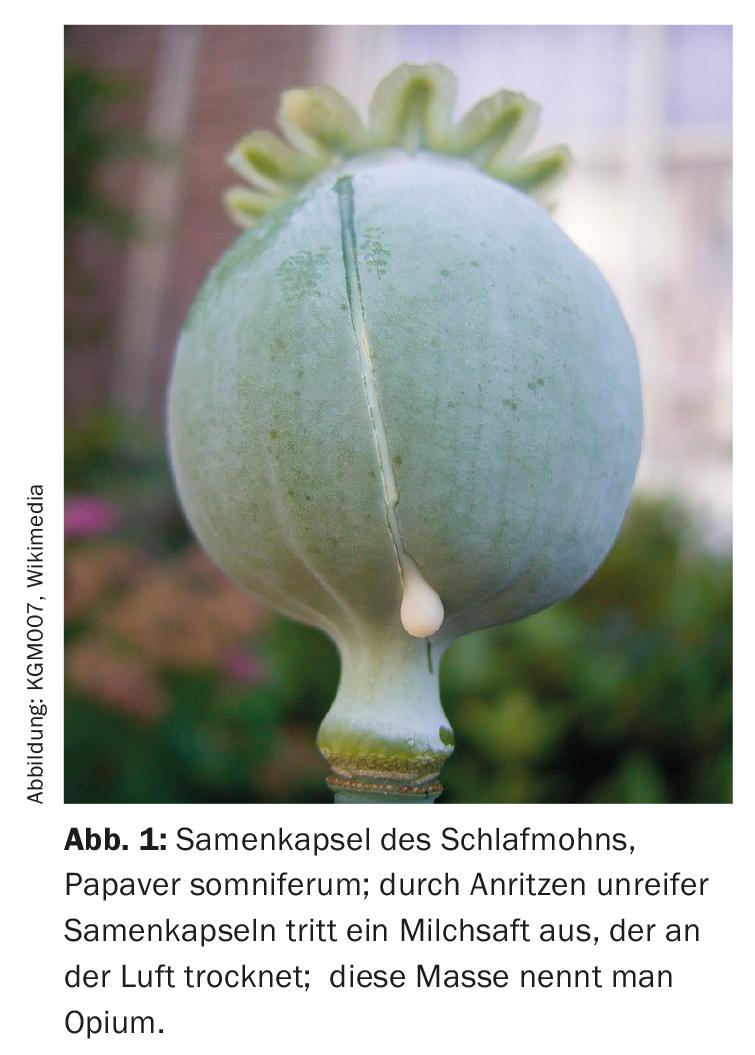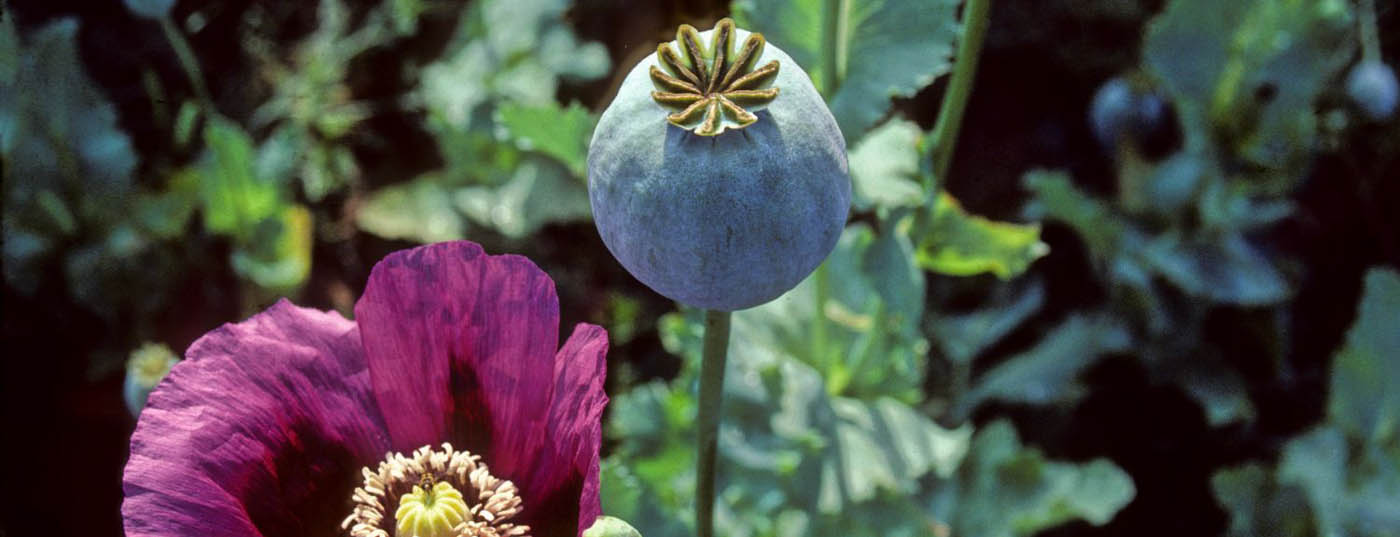Besides the strongest analgesic, morphine, other herbal analgesics are not doing very well. It is true that there are medicinal plants with analgesic potential. However, various difficulties make it almost impossible to use. The most likely use of essential essences is olfactory.
If we look globally at the analgesics that nature provides us with, an interesting fact stands out. Perhaps the most powerful analgesic in existence comes from nature. It is morphine, but it is not actually perceived as a truly natural agent. And yet: morphine is one of the opium alkaloids isolated from the opium poppy, Papaver somniferum (Fig. 1) . Today, the opium poppy is cultivated worldwide. However, in its area of origin, in Southeast Asia, there are still many illegal crops. So morphine is actually a natural substance. In phytotherapy, however, only total extracts from plants are considered true herbal medicines. In this respect, opium, the juice that contains codeine, noscapine, papaverine and other ingredients in addition to morphine, would be a true herbal medicine. Today, however, opium is rarely used medicinally, and when it is, it is often for severe forms of diarrhea. By the way, this application proves that a total extract can have more effects than the sum of the individual ingredients. None of the ingredients of opium known to date has an antidiarrheal effect, but opium juice as a whole does.

Willow, Salix alba
Since opium or morphine cannot be used to treat headaches, a plant analgesic must continue to be sought in nature.
The bark of the (silver) willow Salix alba l., a tree often found in Europe (except Scandinavia), North Africa and parts of Asia, up to 35 meters high, contains various substances, including salicylic acid and salicin, which have analgesic and antiphlogistic potential. Salicin is a so-called glycoside, which consists of a sugar molecule and a substance linked to the sugar. Salicin consists of glucose and saligenin (= salicyl alcohol), which is metabolized in the liver to salicylic acid (Fig. 2).

For some time, isolated salicylic acid was used as an analgesic, antipyretic and antiphlogistic . However, since it often led to lesions of the gastric mucosa, attempts were made to chemically modify salicylic acid to eliminate this side effect. Acetylation of the OH group resulted in acetylsalicylic acid, better known as aspirin.
Salicylic acid was also extracted from the spirea (Filipendula ulmaria), also known as meadowsweet, so that the occasionally large demand could be met.
In the past, extracts from the willow were also used as powder or in capsules as analgesics, i.e. also against headaches. However, its use as an anti-inflammatory has always been in the foreground. In the course of the renaissance of herbal applications, an analgesic and antiphlogistic preparation was on the market in Switzerland for several years, the active ingredient of which was an extract of willow bark. However, it has since been withdrawn from the market, although a recent Cochrane review has affirmed the antiphlogistic efficacy of willow bark preparations [2].
Petasites hybridus, butterbur
Until a few years ago, some herbal analgesics based on butterbur, Petasites hybridus, were available in Switzerland. These were used to treat pain, including headaches. There were also people who were able to successfully treat migraine attacks with butterbur preparations. A clinical trial confirmed the efficacy of butterbur for the treatment of juvenile migraine [1].
Petasites is a plant genus common in the northern hemisphere (Fig. 3), some representatives of which have spasmolytic and analgesic effects due to essential oils, sesquiterpenes, and pyrrolizidine, an alkaloid. In the next issue of HAUSARZT PRAXIS (4/2017), an article will be devoted to butterbur in more detail.

A few years ago, however, it became known that pyrrolizidines have liver-damaging potential. As a result, all butterbur preparations containing butterbur were withdrawn from the market. Only butterbur preparations in which the pyrrolizidine alkaloids are removed from the butterbur during preparation using a special process are now permitted.
Such butterbur preparations are no longer approved for the treatment of pain, but for hay fever and as a combination preparation for sedation. However, they are still occasionally used as an off-label use for pain and headaches.
Tanacetum parthenium, Cannabis sativa
In phytotherapeutic literature, Tanacetum parthenium, motherwort, is repeatedly mentioned as a herbal analgesic. However, there are no studies documenting such efficacy. Moreover, motherwort is not available from any supplier of herbal preparations, even as a tincture.
In addition to the well-known antispasmodic effect of Cannabis sativa, there are repeated reports of an analgesic potential that is said to be contained in hashish. However, a possible application is prevented by the cannabis prohibition or the authorities hardly grant a doctor an exceptional permit for such an indication.
Essential essences
For the treatment of headaches of various etiologies, there is a folk medicine treatment with essential oils (essential essences). For this purpose, various essential essences, such as, peppermint oil, lavender oil, hyssop oil or others are used and applied topically. When a headache or a migraine occurs, these essential oils or a mixture with different essential essences are applied to the temples. There are even clinical studies documenting the effectiveness of such olfactory treatment methods [3].
Summary
There are few herbal strategies for treating pain and headaches. Extracts from willow and butterbur do have analgesic (butterbur) and antiphlogistic (willow) potential. However, there are no corresponding registered drugs. The analgesic effect of motherwort is controversial, and the medicinal plant cannot be purchased. In the case of cannabis sativa, the law prohibits its use. Some effectiveness can be achieved with the olfactory application of essential essences.
Literature:
- Oelkers-Ax R et al: Butterbur root extract and music therapy in the prevention of childhood migraine: an explorative study, Eur J Pain. 2008 Apr; 12(3): 301-13.
- Gagnier JJ et al: Herbal Medicine for Low Back Pain: A Cochrane Review, 2016 Jan; 41(2): 116-33. doi: 10.1097/BRS.0000000000001310.
- Sasannejad P et al: Lavender essential oil in the treatment of migraine headache: a placebo-controlled clinical trial, Eur Neurol. 2012; 67(5): 288-91. doi: 10.1159/000335249.
HAUSARZT PRAXIS 2017; 12(3): 2-3











